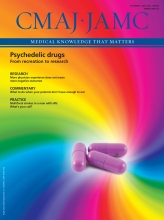Listen to CMAJ editors and authors discuss and comment on the content of this issue. Visit soundcloud.com/cmajpodcasts
Food insecurity and health care costs
Income-related problems with access to food were associated with increased use of health care services and health care costs. This cross-sectional study linked provincial health services data with data on household food insecurity for 67 033 people aged 18–64 who participated in three cycles of the Canadian Community Health Survey between 2005 and 2010. Policy interventions that successfully address food insecurity would likely also reduce health care costs, say the authors. See Research, page E429

Food insecurity is common and is linked to poor health and increased health care costs. Berkowitz and Fabreau discuss the role of clinicians in addressing food insecurity. See Commentary, page 1031
Doctor experience and patient outcomes
Level of physician experience does not affect important patient outcomes that proxy for quality of care. Some physicians’ patients stayed in hospital longer, but quality of care did not differ between physician groups stratified according to years since graduation. See Research, page 1041
Psychedelic medicine makes a comeback

Interest in the use of psychedelic drugs as treatments for illnesses such as anxiety, addiction and posttraumatic stress disorder has been renewed. Early controlled studies of some drugs with psychotherapy have shown promising effects with good safety outcomes. Tupper and colleagues analyze new emerging evidence. See Analysis, page 1054
LSD in the 1960s was linked to counterculture while its clinical trials were marginalized. Today, LSD is making a comeback, especially for end-of-life care. Will an increasing demand by researchers and patients be enough to change its cultural ties to hedonism and drug abuse? See Medicine and society, page 1079
Penicillin allergy
A 25-year-old pregnant woman is found to have late latent syphilis on antenatal testing. She mentions that she had an allergic reaction to penicillin as a child, based on parental report, and therefore cannot receive the standard treatment of penicillin G benzathine injections. Is she really allergic to penicillin? Castellani and colleagues discuss a practical approach to this dilemma. See Decisions, page 1065
Multifocal strokes in HIV infection

A 56-year-old man with untreated HIV infection presented with symptoms and signs consistent with multifocal strokes. He also had several crusted lesions on his body and a single vesicle on his cheek. The authors present an approach to the investigation and management of this complicated case. See What is your call?, page 1067
Cardiac Lyme borreliosis

A 36-year-old man presented with syncope secondary to a new onset of atrioventricular block. Although he had no rash nor known history of tick bite, he was found to have Lyme carditis after extensive investigations. The authors suggest that Lyme carditis should be considered in younger patients with atrioventricular conduction disorders, even without a history of tick bite. See Cases, page 1071
Voriconazole-induced periostitis
A 66-year-old woman with leukemia had shoulder, chest and leg pain while taking voriconazole for invasive neurohistoplasmosis. Investigations were consistent with a diagnosis of voriconazole-induced periostitis, which resolved once the medication was discontinued. Fluorosis and promotion of bone formation is the proposed mechanism, say the authors. See Clinical images, page 1075












Podcast